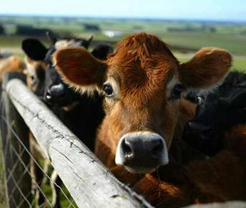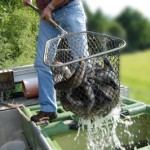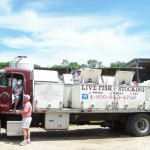 Water, shade, and the right nutrition can help mitigate heat stress in cattle.
Water, shade, and the right nutrition can help mitigate heat stress in cattle.
The weather report says it’s going to be a scorcher, and sure enough – the temperatures start steadily climbing. Cattle start grouping in shady spots. A few cows start panting to stay cool. The flies settle in. And, suddenly, you’ve got a herd struggling with heat stress.
The heat may be unavoidable, but you can take proactive steps to mitigate its impact on your herd. First, let’s look at the dangers of heat stress in cattle.
When temperatures rise
Cattle have sweat glands, but it’s not a very efficient way for them to cool off. Instead, they rely on respiration, or opening their mouths and panting, to help them dissipate heat. When it’s 80 degrees or hotter out, their ability to regulate their own temperature becomes a big challenge. You start to see behavior changes – more time in the shade, less time grazing and increased water consumption.
To make the heat even more challenging:
- A cow’s rumen activity naturally increases body heat. Fermentation occurs in the rumen, producing heat as bacteria break down and digest forages.
- Cattle seek shade to help keep cool. Grouping up in the shade sometimes has the reverse effect and creates a lot of radiant heat between cows. The thermometer might read 90 degrees, but the temperature in the middle of the group could be much hotter.
- Crowded cattle attract more flies, causing animals to move even closer together to protect themselves.
- Animals with dark hides have a higher risk of suffering heat stress than those with lighter-colored hides.
Suddenly your herd feels overheated and cattle are less likely to graze.
When grazing stops
Forage is the number one nutrition source for cows on pasture. If they aren’t grazing as much during a heatwave, they’re probably not meeting their cattle nutrition requirements.
When cows don’t get adequate nutrition, they’re at risk of:
- Losing body condition
- Taking longer to rebreed
- Producing less milk for their growing calf
- Generating a weaker immune response to health challenges
- Long-term fertility consequences
If cattle are too hot to graze, they may also be too hot to consume mineral at target intake levels. If you’re using a fly control mineral and intakes are below target levels, cows no longer benefit from it because they aren’t getting a full dose of fly control.
Curb heat stress in cattle by planning for proper shade, water and the right nutrition program.
11 hot weather tips for cattle
- Ensure access to fresh, clean water. A brood cow drinks 25 to 30 gallons of water on a normal day. She’ll drink even more in hot weather.
- Check water tanks often to make sure they are clean and free of contamination (algae, feces, organic material, etc.). You might need additional portable tanks to ensure adequate access.
- Place water tanks in shaded areas to keep water cool if possible. Keep waterers several feet away from buildings or fences, so cattle can access water from all sides.
- Offer supplements to help cows make the most of their forages. Accuration® Supplements with Intake Modifying Technology® helps feed necessary rumen microbes to keep cattle eating and encourages snack eating behavior.
- Choose a mineral designed for consistent consumption during hot weather, like Purina® Wind and Rain® Summer Season Mineral.
- Control flies to prevent further stress and grazing disturbance. Purina® Wind and Rain® Fly Control Mineral contains Altosid® IGR, an insect growth regulator offering a beneficial mode of action to deliver fly control via cattle nutrition. Consider Purina® Wind and Rain® Fly Control Mineral to stop the horn fly life cycle by preventing pupae from developing into biting, breeding adult flies.
- Supply ample shade. Whether it’s provided by trees, a manmade building or portable structures, shade is critical. It might be necessary to move cattle to a pasture with trees or additional shade.
- Strategically move rotational grazing herds to fresh pastures in the late afternoon/early evening instead of the morning. Cows will have access to fresh grass when temperatures are beginning to cool and will be more likely to graze.
- Work cattle as early in the day as possible when temperatures are lower.
- Don’t graze pastures short before moving cows to another. Pastures with taller, thicker grass feels cooler than pastures with short grass where more soil surface is exposed.
- Observe cattle frequently and take precautions when hot and humid weather is forecast.
Source: Chris Forcherio, Ph.D.
Beef Research Manager



